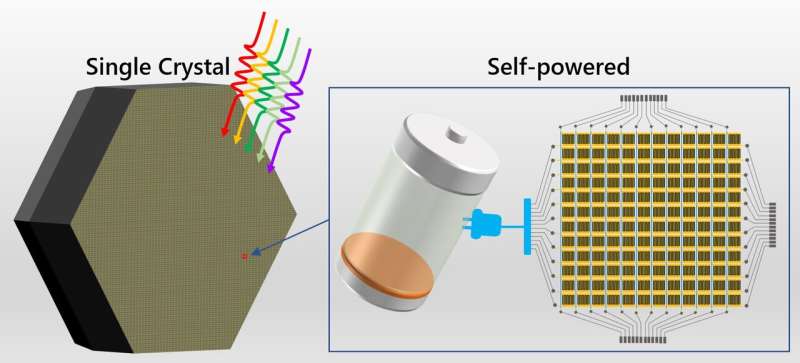Inch-sized high-quality perovskite single crystals formed by suppressing the phase segregation for applications in light-powered integrated circuits. Credit: DICP
Multiple-cation and mixed-halide (FAMACs) perovskites, which are formed by incorporating Cs/MA/Br ions into the FAPbI3 perovskites, are considered as the best compositions for applications in high-efficiency photovoltaic and photoelectronic devices owing to their enhanced stability, suppressed ion migration, and reduced hysteresis. However, the actual composition, especially the content of Cs in FAMACs perovskites, for the state-of-the-art devices reported by different research groups has been inconsistent.
Furthermore, phase segregation into the yellow non-perovskite phase is often observed during the crystallization process. This undesirable yellow phase acts as trapping states or scattering centers, which has a negative impact on the charge carrier mobility and carrier recombination dynamics, thereby deteriorating the device performance.
Recently, a research group led by Prof. Liu Shengzhong from the Dalian Institute of Chemical Physics (DICP) of the Chinese Academy of Sciences (CAS), in collaboration with Prof. Liu Yucheng from Shaanxi Normal University, and Prof. Mercouri G. Kanatzidis from Northwestern University (Evanston), proposed an efficient strategy for obtaining high-quality perovskite single crystals with a size up to 5 inches. The large and pure phase single crystals were used to design high-performance self-powered integrated-circuit photodetectors.
This work was published in Science Advances.
The researchers selected a reducing agent, formic acid, for suppressing phase segregation during the crystallization process to obtain very large triple-cation mixed-halide perovskite single crystals. This strategy yielded state-of-the-art perovskite single crystals with long carrier lifetime, high charge mobility, long carrier diffusion distance, superior uniformity, and long-term stability, thereby facilitating the design of high-performance self-powered integrated-circuit type photodetectors.
Moreover, since the photodetector comprising the crystal exhibited large responsivity, high photoconductive gain, excellent detectivity, and fast response speed, an integrated imaging system with uniform photo-response was fabricated based on a 12 by 12 pixelated matrix of single crystal photodetectors.
For example, a 2 by 2 pixel matrix showed good discrimination between pixels upon selective illumination.
"We believe that such a novel design will open new avenues for the applications of perovskite self-powered integrated circuits in devices relevant to imaging applications," said Prof. LIU.
More information: Inch-sized high-quality perovskite single crystals by suppressing phase segregation for light-powered integrated circuits. Science Advances (2021). advances.sciencemag.org/lookup … .1126/sciadv.abc8844
Journal information: Science Advances
Provided by Chinese Academy of Sciences
























